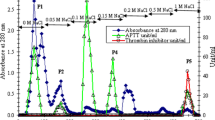Abstract
Tabanus anticoagulant protein (TAP) was isolated from the whole body of the tabanus,Tabanus bivittatus, using three purification steps (ammonium sulfate fractionation, gel filtration on Bio-Gel P-60, and ion exchange chromatography on DEAE Sephadex gel). The purified TAP, with a molecular weight of 65 kDa, was assessed to be homogeneous by SDS-polyacrylamide gel electrophoresis, and an isoelectric point of 7.9 was determined by isoelectric focusing. The internal amino acid sequence of the purified protein was composed of Ser-Leu-Asn-Asn-Gln-Phe-Ala-Ser-Phe-lle-Asp-Lys-Val-Arg. The protein was activated by Cu2+ and Zn2+, and the optimal conditions were found to be at pH 3–6 and 40–70°C. Standard coagulation screen assays were used to determine thrombin time and activated partial, thromboplastin time. Chromogenic substrate assays were performed for thrombin and factor Xa activity. TAP considerably prolonged human plasma clotting time, especially activated partial thromboplastin time in a dose-dependent manner; it showed potent and specific antithrombin activity in the chromogenic substrate assay. Specific anti-factor Xa activity in TAP was not detected. Overall, this result suggested that TAP has significant anticoagulant activity on blood coagulation system.
Similar content being viewed by others
References
Ahn, M. Y., Ryu, K. S., Lee, Y. W., and Kim, Y. S., Cytotoxicity andl-amino acid oxidase activity crude insect drugs.Arch. Pharm Res., 5, 477–481 (2000).
Ahn, M. Y., Hahn, B. S., Ryu, K. S., and Cho, S. I., Effects of insect crude drugs on blood coagulation and fibrinolysis system.Natural Product Sciences, 8, 66–70 (2002).
Ahn, M. Y., Hahn, B. S., Ryu, K. S., Kim, J. W., Kim, I., and Kim, Y. S., Purification and characterization of a serine protease with fibrinolytic activity from dung beetles,Catharsius molossus, Thrombosis Research, 112, 339–347 (2003).
Astrup, T. and Mullertz, S., The fibrin plate method for estimating of fibrinolytic activity.Arch Biochem Biophys, 40, 346–351 (1952).
Bradford, M. M., A rapid and sensitive method for the quantitation of microgram quantities of protein utilizing the principle of protein-dye binding.Anal Biochem, 72, 248–254 (1976).
Grevelink, S. A., Youssef, D. E., Loscalzo, J., and Lerner, E. A., Salivary gland extracts from the deerfly contain a potent inhibitor of platelet aggregation.PNAS, 90, 9155–9158 (1993).
Kazimírová, M., Sûlanová, M., Trimnell, A. R., Kozánek, M., VidliĈka, L., Labuda, M., and Nuttall, P. A., Anticoagulant activities in salivary glands of tabanid flies.Med. Vet. Entomol., 16, 301–309 (2002).
Kazimírová, M., Sjulanová, M., Kozánek, M., Takáč, P., Labuda, M., and Nuttall, P. A., Identification of Anticoagulant Activities in Salivary Gland Extracts of Four Horsefly Species (Diptera, Tabanidae).Haemostasis, 31, 294–305 (2001)
Laemmli, U. K., Cleavage of structural proteins during the assembly of the head of bacteriophage T4.Nature, 227, 680–685 (1970).
Markwardt, F. and Leberecht, E., Untersuchungen über den blutgerinnung-shemmenden Wirkstoff der Tabaniden.Naturwissenschaften, 46, 17–18 (1959).
Markwardt, F. and Schulz, E., Über den Mechanismus der blutgerinnungshemmenden Wirkung des Tabanins.Naunyn-Schmiedeberg's Archiv für Experimentelle Pathologie Undpharmakologie, 238, 320–328 (1960).
Markwardt, F., Coagulation inhibitors from animals feeding on blood.Rev Iberoamer Tromb Hemost, 7, 225–231 (1994).
Ouriel, K., Current status of thrombolysis for peripheral arterial occlusive disease.Ann Vas Surg, 16, 797–804 (2002).
Reddy, V. B., Kounga, K., Mariano, F., and Lerner, E. A., Chrysoptin is a potent glycoprotein lib/llla fibrinogen receptor antagonist present in salivary gland extracts of the deerfly.J. Biol. Chem., 275, 15861–15867 (2000).
Ribeiro, J. M. C., Vachereau, A., Modi, G. B., and Tesh, R. B., A novel vasodilatory peptide from the salivary glands of the sand flyLutzomyia longipalpis.Science, 243, 212–214 (1989).
Author information
Authors and Affiliations
Corresponding author
Rights and permissions
About this article
Cite this article
Ahn, M.Y., Hahn, B.S., Lee, P.J. et al. Purification and characterization of anticoagulant protein from the Tabanus,Tabanus bivittatus . Arch Pharm Res 29, 418–423 (2006). https://doi.org/10.1007/BF02968593
Received:
Issue Date:
DOI: https://doi.org/10.1007/BF02968593




